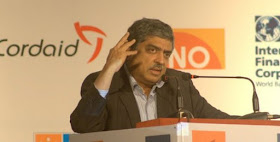Microfinance Focus, December 12, 2011:
Nandhan Nilekani, Chairman, Uniqie Identification Authority of India (UIDAI) today said the initiative of assigning a Unique Identification Number - Aadhar - has already reached 140 million Indians and is expected to meet its target of 200 million by end of March 2012.
Nilekani was speaking at the Microfinance India Summit in New Delhi. “From a point of view of financial services, an Aadhar number allows to KYC (know your customer). It reduces barrier to getting entry to a financial product.
Over time there will be KYC conversion for various products such as your bank account or loan product or pension product or mobile phone.
The aim is to create a common KYC across products. Aadhar can be a financial address”, he said.
Highlighting the benefits of Aadhar, he said that an online verification brings down the cost of transactions.
“Millions of people with an online ID they can go to various locations to do online transactions. The payment network will be common. It allows for mobile transactions. It would be agnostic products platform of identity and payments. On this platform you can build various financial products”.
Speaking about Aadhar’s scalable structure, Nilekani said that its enrolment software allows for the issuance of more than a million a day.
“It is important, as it is the world’s first online ID. There are two ways. One is through the biometric ID on who you are. The second way is through an OTP, one time pin sent to your mobile. You can also set your own authentification features. It is not only about giving identity but an online identity”, he said.
The Unique Identification number (UID) is an initiative of the Government of India, which identifies individuals uniquely on the basis of their demographic information and biometrics that will give individuals the means to clearly establish their identity to public and private agencies across the country.
It will also create an opportunity to address the existing limitations in financial inclusion. The UID can help poor residents easily establish their identity to banks. As a result, banks are expected to scale up their branch-less banking deployments and reach out to a wider population at lower cost.
